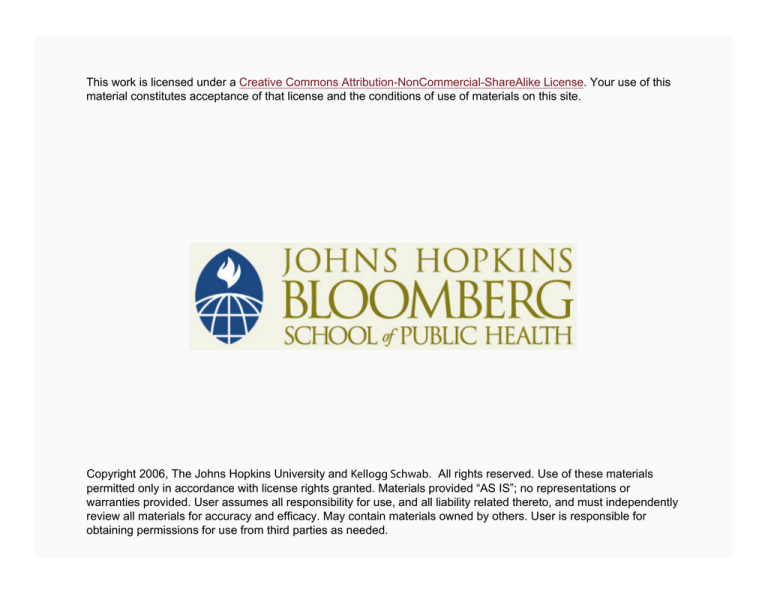
This work is licensed under a Creative Commons Attribution-NonCommercial-ShareAlike License. Your use of this
material constitutes acceptance of that license and the conditions of use of materials on this site.
Copyright 2006, The Johns Hopkins University and Kellogg Schwab. All rights reserved. Use of these materials
permitted only in accordance with license rights granted. Materials provided “AS IS”; no representations or
warranties provided. User assumes all responsibility for use, and all liability related thereto, and must independently
review all materials for accuracy and efficacy. May contain materials owned by others. User is responsible for
obtaining permissions for use from third parties as needed.
Biological Agents of Water and Foodborne
Bioterrorism
Kellogg Schwab PhD
Johns Hopkins University
Objectives
Outline microbes as biological weapons
− Response, exposure, transmission
Microbial characteristics of interest to perpetrators
− Availability
− Propagation
− Stability
− Dispersion
CDC biological classifications of bioterrorism microbes
Food and waterborne microbial threats
− Microbial properties
− Specific microorganisms
Part 1 of 5
Microbes as Biological Weapons
Microbes as Biological Weapons
The microorganisms and toxins that could act as biological
weapons are naturally occurring.
The agents that could potentially be used as biological
weapons are diverse and widely distributed in nature and
include
− viruses, bacteria, fungi, and protozoa
− the toxins produced by many microbes
These microbes are found naturally in soils, waters, plants,
and animals.
Infectious Diseases Cause Severe Morbidity and Mortality
Despite all the medical advances that enhance our abilities to
prevent and treat disease, infectious diseases remain the
primary cause of death in the world and are one of the
leading causes of death in the US.
There are over 50,000 cases of infectious diseases in the
United States each day.
Outbreaks of disease from pathogenic microorganisms pose a
threat to global security even without biological warfare or
bioterrorism.
Biological Weapons are Living Microorganisms
An important feature that distinguishes biological weapons
from other weapons of mass destruction is that
microorganisms reproduce once inside a host.
It can take only a few hours to go from having 1
microorganism to millions of infectious agents.
In some cases it requires exposure to only a few of these
pathogens to initiate a deadly infection.
Delay in Symptoms can Complicate the Response
Typically individuals don't know they were exposed to an
infectious agent until days or weeks later when the disease
symptoms appear.
This means that the first responders to an attack with
biological weapons may be emergency room workers.
If the agent can be transmitted from person to person
through the air or by direct contact with body fluids these
health care workers can themselves become infected.
If the risk is apparent, steps, such as wearing masks and
gowns, can be taken to protect these first responders and to
limit the spread of infection.
But if the risk is not properly recognized the health care
workers and others may also become victims.
− SARS is a classic example of this
Biological Exposure Routes
Biological agents vary in how they are transmitted to humans
and how they enter the body.
Transmission of biological agents through the air (aerosol
transmission) is likely to impact the greatest number of
individuals, but transmission by other means--water, food,
insect vectors, etc.--may also be routes of exposure of
individuals to biological agents.
Differences in Effects and Transmissibility
Among the viruses, bacteria, and fungi that may be used as
biological weapons, there are significant differences in their
effects and transmissibility.
Not all of the agents that may serve as potential biological
weapons are equally contagious.
They also differ greatly in the rates of morbidity (disease) that
occur following exposure and mortality (death) that occur as
a consequence of disease development.
This has a significant impact on the threat posed by each
specific biological agent and how we might defend against
them.
Disease Outcomes
Exposure to biological agents can have various outcomes,
ranging from mild disease with few symptoms to severe
disease and high rates of mortality. Some diseases, like many
of the hemorrhagic fevers (Ebola, Marburg, etc.), can not be
prevented, except by avoiding exposure.




